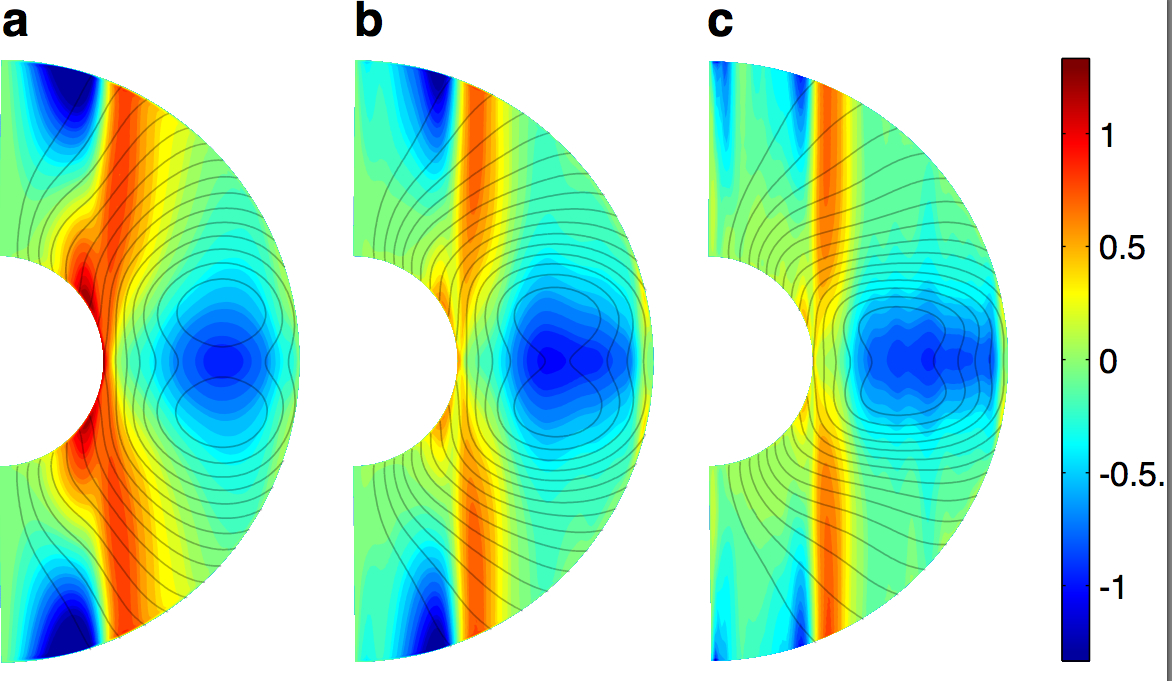Axial inner core rotation and oscillation
The rigid centre of our planet, the inner core, is not rotating at a uniform rate. This is inferred from the travel time of seismic waves traveling through the inner core.
As a fun historical note, Edmund
Halley (of comet fame) was the first to suggest that the Earth comprised an inner core
and that it was rotating at a different rate than the mantle (See Fig
1, below). This suggestion appears in a Philosophical Transaction of
the Royal Society paper in 1692. Halley's suggestion was motivated by observations of the
Earth's magnetic field, which was then thought to
be purely produced by permanent magnetization. Halley's idea of a
differentially rotating "inner core" with its own magnetization could
explain the observed changes of the magnetic field.
For many years, it remained unclear whether the differential inner core rotation inferred by
seismic observations represented a steady rotation -- driven by a
thermal wind profile in the region above and below the inner core --
or a time-dependent rotation. In my previous work on this topic (in
collaboration with Jon Mound, University of Leeds), we show that bounds on each of these
possible scenarios can be placed on the basis of angular momentum
dynamics. In turn, this places useful constraints on quantities such
as the inner core viscosity and the conductance at the base of the
mantle. Together with my colleague Julien Aubert (IPGP, Paris), we have investigated
this question using numerical models of the geodynamo. Our
conclusion is that the present-day differential rotation of the inner
core most likely represents a fragment of a long timescale (hundreds
of years) time-dependent motion rather than a steady super-rotation. This conclusion has now been confirmed by the most recent seismic investigations, which are now sufficiently resolved to highlights these fluctuations in rotation.

Figure 1: Edmund Halley's model to explain the Earth's magnetic field changes. Color patches represent permanent magnetization. |

Figure 2: Meridional slice showing the time-averaged zonal flow structure in a numerical simulation of the geodynamo using a decreasing viscosity from left to right. Red (blue) corresponds to eastward (westward) flow. The change in the flow structure near the inner core boundary leads to a change in the amplitude of the torque on the inner core, and to its differential rotation rate. The black lines are superimposed magnetic field lines. Figure taken from Aubert & Dumberry, GJI, 2011.
|
Some of my papers on this topic
Dumberry, M., 2011, A new twist on inner-core spin, Nature Geoscience, 4, 216-217.
Aubert, J., Dumberry, M., 2011, Steady and fluctuating inner core rotation in numerical geodynamo models, Geophys. J. Int., 184, 162-170.
Dumberry, M., 2010, Gravitationally driven inner core differential rotation, Earth Planet. Sci. Lett., 297, 387-394.
Dumberry, M. and Mound, J., 2010, Inner core-mantle gravitational locking and the super-rotation of the inner core, Geophys. J. Int., 181, 806-817.
Dumberry, M., 2007, Geodynamic constraints on the steady and time-dependent inner core axial rotation, Geophys. J. Int., 170, 886-895.

